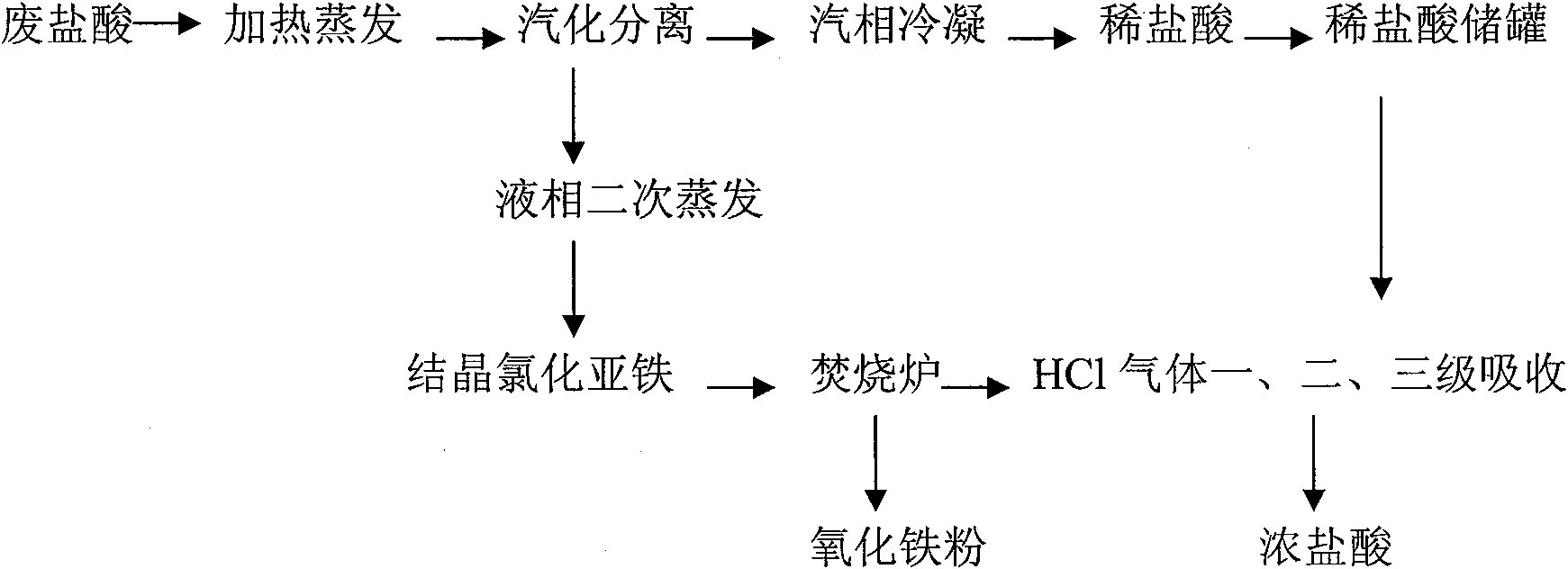Process for recycling iron/steel acid-washing waste hydrochloric acid through evaporation burning and coupling process
A technology of iron and steel pickling waste and waste hydrochloric acid, which is applied in the direction of chlorine/hydrogen chloride, etc., can solve the problems of large investment, large floor space, and high energy consumption, and achieve the effects of low operating costs, energy saving, and reduced energy consumption
- Summary
- Abstract
- Description
- Claims
- Application Information
AI Technical Summary
Problems solved by technology
Method used
Image
Examples
example 1
[0028] Example 1 uses evaporation-incineration coupling process to recover waste iron and steel acid.
[0029] The waste acid from the steel pickling waste hydrochloric acid storage tank is pumped to the evaporator for heating and vaporization. The vapor-liquid mixture is vaporized, flashed and separated in a high-efficiency anti-corrosion vaporizer, so that 70% of the water and hydrochloric acid in the waste acid are evaporated, and the liquid phase is greatly concentrated to make the specific gravity reach 1.6g / cm3. The vapor phase is sent to the condenser to be condensed to recover dilute hydrochloric acid, and sent to the dilute acid storage tank. The ferrous chloride-containing concentrated liquid separated from the high-efficiency anti-corrosion evaporator is sent to the evaporation crystallizer for deep evaporation, concentration, cooling, and crystal nucleus formation. The evaporated hydrochloric acid vapor is condensed through the condenser to recover dilute hydrochl...
example 2
[0032] Example 2 uses evaporation-incineration coupling process to recover waste iron and steel acid.
[0033] The waste acid from the steel pickling waste hydrochloric acid storage tank is pumped to the evaporator for heating and vaporization. The vapor-liquid mixture is vaporized, flashed and separated in a high-efficiency anti-corrosion vaporizer, so that 60% of water and hydrochloric acid in the waste acid are evaporated, and the liquid specific gravity reaches 1.4g / cm3. The vapor phase is sent to the condenser to be condensed to recover dilute hydrochloric acid, and sent to the dilute acid storage tank. The ferrous chloride-containing concentrated liquid separated from the high-efficiency anti-corrosion evaporator is sent to the evaporation crystallizer for deep evaporation, concentration, cooling, and crystal nucleus formation. The evaporated hydrochloric acid vapor is condensed through the condenser to recover dilute hydrochloric acid, which is also sent to the dilute ...
example 3
[0036] Example 3 uses evaporation process to recycle waste hydrochloric acid containing oxalic acid in rare earth production.
[0037] The waste acid from the waste hydrochloric acid storage tank of the rare earth production line is pumped to the evaporator for heating and vaporization. The vapor-liquid mixture is vaporized, flashed and separated in a high-efficiency anti-corrosion vaporizer, so that 65% of water and hydrochloric acid in the waste acid are evaporated, and the specific gravity of the liquid reaches 1.5g / cm3. The vapor phase is sent to the condenser to be condensed to recover dilute hydrochloric acid, and sent to the dilute acid storage tank. The oxalic acid-containing concentrated liquid separated from the high-efficiency anti-corrosion vaporizer is sent to the cooling crystallizer for cooling and cooling to form crystal nuclei. Finally, it is sent to a crystallization filter for solid-liquid separation, and the obtained crystalline oxalic acid and a small amo...
PUM
 Login to View More
Login to View More Abstract
Description
Claims
Application Information
 Login to View More
Login to View More - R&D
- Intellectual Property
- Life Sciences
- Materials
- Tech Scout
- Unparalleled Data Quality
- Higher Quality Content
- 60% Fewer Hallucinations
Browse by: Latest US Patents, China's latest patents, Technical Efficacy Thesaurus, Application Domain, Technology Topic, Popular Technical Reports.
© 2025 PatSnap. All rights reserved.Legal|Privacy policy|Modern Slavery Act Transparency Statement|Sitemap|About US| Contact US: help@patsnap.com

